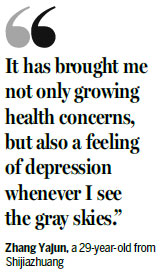

Beijing-Tianjin-Hebei region is targeting a reduction in the concentration of PM2.5
Residents in northern regions, including Beijing, Tianjin and Hebei province, will encounter another bout of severe smog starting on Friday night that is forecast to last until Dec 21, the national meteorological authority said on Wednesday.
The coming pollution is forecast to reach hazardous levels, peaking on Tuesday and Wednesday next week, with visibility in some areas lowered to 1 kilometer, the National Meteorological Center said on Wednesday.
The smog will cover vast regions including Beijing, Tianjin and parts of Hebei, Shanxi, Henan and Shaanxi provinces. Wind is expected to disperse the pollutants after Dec 21, it added.

"I have lost count of the number of smoggy days since November, and it has brought me not only growing health concerns, but also a feeling of depression whenever I see the gray skies," said Zhang Yajun, a 29-year-old from Shijiazhuang, capital of Hebei province.
On Dec 3 and 4, Shijiazhuang saw the Air Quality Index reach the most hazardous level so far this month.
Since the beginning of October, the city has had 15 more smoggy days than the same period last year, the national meteorological authority said.
"I know we have done a lot to reduce emissions, like suspending some polluting industries, and I wish to see things improve quickly," Zhang said.
The deterioration in some northern areas was noted by the Ministry of Environmental Protection, and its latest monthly report on air quality, it revealed an increase in the concentration of fine particulate matter in the region in November.
By 2017, the Beijing-Tianjin-Hebei region is targeting a reduction in the concentration of PM2.5 - fine particulate matter with diameter of 2.5 microns or less that is hazardous to human health - by 25 percent from 2013 levels.
Hebei is facing growing pressure to reduce air pollution, especially due to frequent severe smog. But based on previous restriction measures, it will be difficult for Hebei to reach its target on time, said He Kebin, head of the School of Environment at Tsinghua University.
"But the province has strengthened its restrictions to cover more companies and has stricter emission standards, which could help the province reach its goals by 2017, as long as it can fully enforce them," He said.
zhengjinran@chinadaily.com.cn